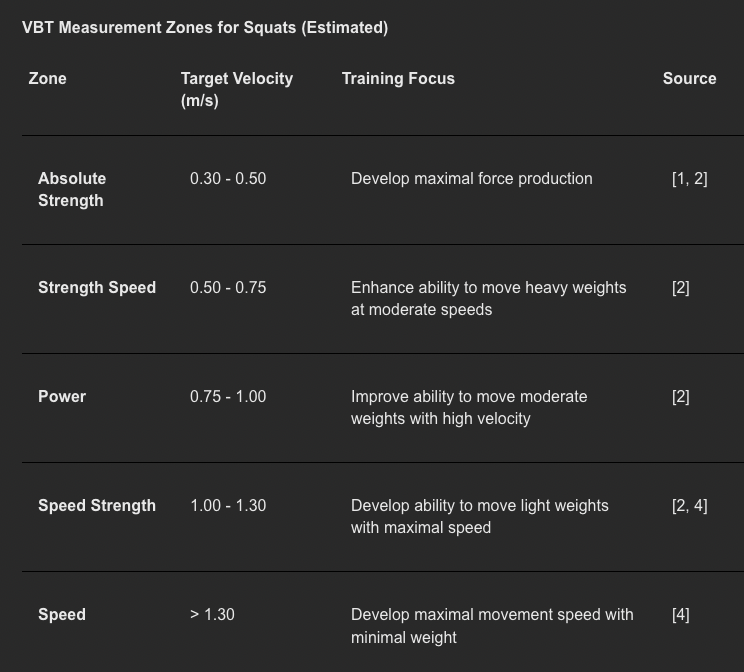
It's extremely difficult to progress without measuring progress. velocity-based training (VBT) is an excellent method of measuring progress in action. This relatively “newer” method uses movement speed to optimize your workouts and programming, offering a range of benefits for athletes and everyday exercisers alike.
In athletic training facilities, VBT stands for Velocity Based Training. Velocity is distance divided by time. VBT training is a way of training that uses your movement speed to design your workouts and track your progress. Here's the breakdown:
Focus on Speed: Instead of just weight or reps, VBT looks at how fast you can move the weight. This provides a more precise picture of how hard you're actually working.
Personalized Training: Because everyone lifts differently, VBT tailors the workout intensity to you. This helps you avoid overtraining or plateaus.
Biofeedback Tool: By tracking changes in your lifting speed, VBT can tell you how your body is responding. A drop in speed might indicate fatigue or approaching injury, allowing you to adjust your workout.
Better Recovery: Monitoring your velocity over time can reveal how effective your recovery program is. If your speed isn't bouncing back as expected, you might need more rest or adjustments to your sleep or nutrition.
Progress Tracking: VBT goes beyond feeling stronger. It allows you to see concrete improvements in your strength, power output, and overall performance, measured down to the fraction of a second.
Listen to Your Body:
VBT acts like a fitness biofeedback tool. By tracking changes in velocity, you can gain valuable insights into your body's readiness. A significant drop in speed might indicate approaching fatigue or potential injury, allowing you to adjust your training accordingly. This is especially helpful for adults whose bodies may respond differently day-to-day. Why is this important?
Many adults that casually workout to lose weight or stay in shape will have good and bad gym days, and not necessarily know why a workout they have done many times suddenly feels too heavy. With proper warm up sets and working up to the highest load properly, VBT can help adults identify when they should stop increasing the load and risk injury, such as “pulling their back”.
In addition, most adults should be working with some level of progressive overload. But, many adults have no idea when they should increase load and by how much, therefore potentially exposing themselves to injury. VBT training provides a speed to help adults know when it is a good time to increase the load. For example, an adult wanting to increase their squat load can utilize VBT to take the guesswork out. If at the heavier end of the squat day the VBT is showing a reading of 0.7, the generally accepted principle is to increase the load until your VBT reading is within the 0.30 - 0.50 range, as shown in the chart below.
Important Notes:
These are estimated ranges and may vary depending on the individual athlete, training experience, and squat variation (back squat vs. front squat).
References 1 & 2 focus on the Minimum Velocity Threshold (MVT) which is the velocity achieved during a successful 1RM attempt. The zones listed here are a broader range based on the MVT.
Reference 4 highlights that these zones can be athlete and exercise specific.
How does VBT apply to athletes? We recently had a father come to us to help his daughter improve her basketball game, but was adamant that he “see results”. Of course, improved performance on the court, feedback from trainers and the basketball coach and increased loads are valuable tools to use to identify if a training program is providing results. However, VBT measurements can show exactly by how much an athlete is improving.
Avoiding Injury In Season - We all want to avoid injury. It has been said, “Your greatest ability is availability”. Even if an athlete is very skilled, they will not have play time if they are out due to injury. Many younger athletes have experience in the weight room, but have no knowledge of how to safely progress without risking injury. Fatigue can lead to injury, which makes in-season VBT training even more valuable. For example, an intermediate baseball athlete weighing 165 lbs may regularly bench 185 lbs without issues, and may want to increase the load. However, in season there is increased risk of fatigue, and 185lbs in-season can have a different effect on the body than in the off-season. If the VBT measurement shows the athlete has reached the standard speed for 185lbs before reaching 185, lets say at 175lb, it is generally accepted to consider ending that weight training session at 175lb to stay safe.
Benefits for Everyone:
VBT isn't just for elite athletes. Here at D1 Henderson, we understand that everyone benefits from a data-driven approach. Whether you're a seasoned athlete or a weekend warrior, VBT can help you track your progress in a way that traditional methods can't. Experience improvements in strength, power output, and overall performance – all measured down to the crucial fraction of a second.
The D1 Henderson Advantage:
Our facility boasts cutting-edge velocity tracking equipment, providing you with the data you need to excel. Seeing your progress quantified is a fantastic motivator, keeping you engaged and on track towards your fitness goals. Future blogs will delve deeper into VBT training for specific sports.
VBT is the missing piece that can round out your training program at D1 Henderson. Come experience the difference and unlock your full potential!

